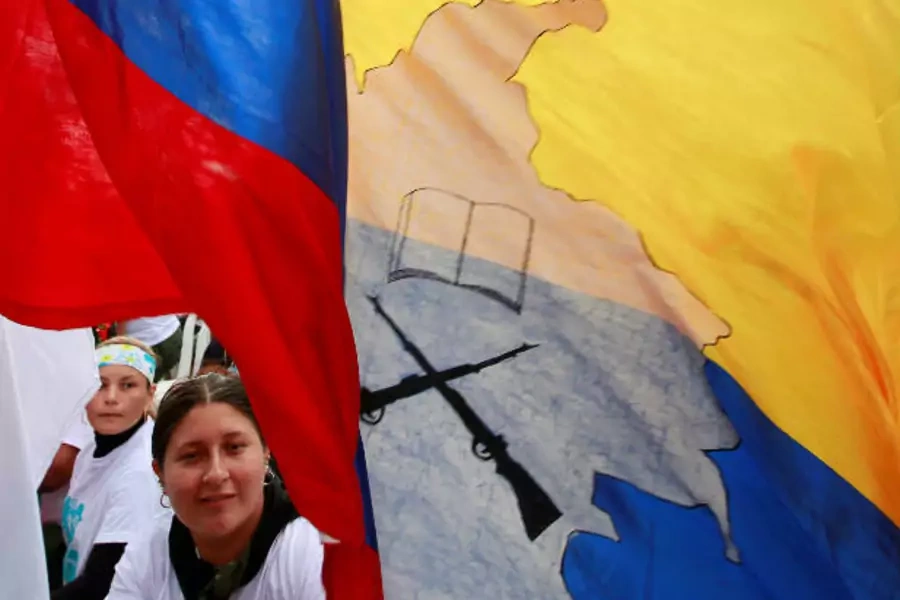Despite ‘No’ Referendum, Colombia Peace Process Remains a Model for Women’s Participation

More on:
Voices from the Field features contributions from scholars and practitioners highlighting new research, thinking, and approaches to development challenges. This article is authored by Mayesha Alam, who is based at Yale University and conducted research fieldwork in Colombia earlier this year on behalf of the Georgetown Institute for Women, Peace and Security. She is the author of Women and Transitional Justice (Palgrave Macmillan 2014) and co-editor of Gender and Women in Military Operations (Georgetown University Press anticipated 2017).
After more than half a century of civil war, Colombians voted in a referendum to reject a peace agreement between the government and the Revolutionary Armed Forces of Colombia (known commonly as FARC). This vote came after years of intense negotiations in Havana mediated by an array of international actors. The result is a major blow to Jose Manuel Santos’ administration. What went wrong with the plebiscite will surely be the topic of many autopsies by external observers and soul-searching by those who shepherded the peace process.
Despite the outcome, the comprehensive peace agreement is remarkable for many reasons, not least of which is the mainstreaming of gender equality and women’s rights across the various accords. This is, in no small measure, thanks to the participation of women, in civil society and at the formal negotiating table, who have been at the forefront of the peacemaking effort.
Women are part of the leadership of the FARC and government peace panels; their imprints can be seen in the progress of the talks and in the language of the accords. For example, Elena Ambrosi, who largely served as penholder for the government and led the drafting of the peace accords, described the persistence and patience required in overcoming impasses during the arduous negotiations. Victoria Sandino of the FARC delegation admitted recently that the FARC had made “mistakes, very painful ones” during the war, but that a peaceful future was possible thanks to the mutually agreed upon framework. Indeed, women’s leadership has been key to the inclusive peace plan—but their presence is only one noteworthy aspect.
In 2014, a gender sub-commission was created that brought together government and FARC negotiators with technical experts and advisers to focus on priority issues affecting women and critical to peacebuilding. Women in civil society mobilized across the country in support of peace. Women’s non-governmental organizations such as Ruta Pacífica de las Mujeres and Sisma Mujer, as well as indigenous or Afro-Colombian groups such as the National Association of Indigenous and Peasant Women and AFRODES, have played significant roles, too. Their advocacy, outreach, coalition building, and substantive proposals have facilitated grassroots peacebuilding and shaped the agenda of high-level peace talks.
Women’s participation in the peace process has been strongly encouraged and enabled by international partners such as the Norwegian Ministry of Foreign Affairs, UN Women, and the International Center for Transitional Justice. At the same time, women’s senior appointments to various Colombian government agencies engaged in the peace process—including the Office of the High Commissioner for Peace, the Victims Unit, Ministry of Justice, and Ministry of the Interior—has been salient to institutional integration of women’s perspectives and experiences.
The accords cover a wide range of deeply contentious and highly complex issues such as demobilization and reintegration, land reform, access to services, and justice and accountability. An array of gross human rights abuses—including forced disappearance, displacement, kidnapping, torture, massacres, and rape—characterized the civil war. Sexual violence, in particular, was an acutely sensitive issue for negotiating parties to navigate, but one that victims groups and international observers, including the ICC, advocated for adamantly. Fatou Bensouda, ICC chief prosecutor, reaffirmed victims’ right to redress earlier this month when she noted with approval, “[T]he final text of the peace agreement excludes amnesties and pardons for crimes against humanity and war crimes under the Rome Statute.” Bensouda also reminded, “The peace agreement acknowledges the central place of victims in the process and their legitimate aspirations for justice. These aspirations must be fully addressed, including by ensuring that the perpetrators of serious crimes are genuinely brought to justice.” Earlier this year, when victims groups were invited to present to the negotiating panel in Havana, women who were raped and subjected to other crimes testified about their wartime experience. Sexual violence, however, is hardly the only issue that affects women.
Women comprise as much as 40 percent of the FARC fighters. Gender mainstreaming in the demobilization, reintegration, and rehabilitation efforts will therefore be central to implementing an eventual peace agreement. In addition to employment and alternative livelihoods for former guerillas, there are issues of trauma that must be addressed. Land tenure—including the ability of forcibly displaced populations to return or make legitimate claims to territory—is another disputed topic with important gender dimensions. The peace accords recognize the unique challenges women face to formally acquire and retain land and, as such, include provisions to enable titling for marginalized women. Political reconciliation, while necessary for sustainable peace, is not sufficient; social reconciliation will be essential to preventing conflict recidivism. For this, truth telling and transitional justice measures will be important—even if messy—and must include women from a variety of ethnic, geographic, and socioeconomic backgrounds in order to be far-reaching and representative of Colombia’s diversity.
Colombia’s peace process has been far from perfect, but it does represent an important model of gender mainstreaming. There are important lessons to glean for the future, especially considering the historical and systematic exclusion of women from peacemaking throughout the world. Although it remains to be seen where the government and FARC will go from here, the durability of peace in Colombia will depend on not only commitment to aggregate implementation of a final agreement but also the public’s support in the long run. The ability of women to benefit from and participate in implementing peace will shape the future of democracy in Colombia.
More on:
 Online Store
Online Store